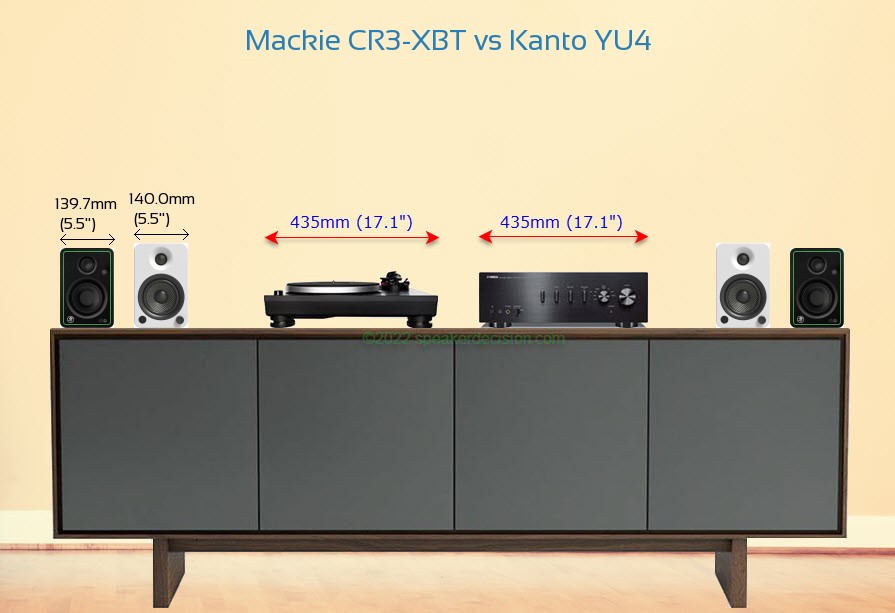In this review, we will be comparing Mackie CR3-XBT and YU4, two Powered Bookshelf speakers from Mackie and Kanto. Being Powered speakers, they both have built-in amplifiers so you don't need an external power amp or an integrated amp to power them.
Let's have a brief look at the main features
of Mackie CR3-XBT and Kanto YU4 first before getting into our more
detailed comparison.
Mackie CR3-XBT Key Specs
- 2-way Design
- 25-watt RMS( 50-watt Peak) Integrated Amplifier
- 0.75" Dome Tweeter
- 3" Polypropylene Woofer
- 80-20k Hz Frequency Response
- N/A Max Depth / N/A Max Sample Rate
- Built-in 4.2 Bluetooth
- Dimensions (H x W x D): 206.4" x 5.5" x 7.5"( 206.4 x 139.7 x 190.5mm )
Kanto YU4 Key Specs
- 2-way Design
- 70-watt RMS( 140-watt Peak) Integrated Amplifier
- 1" Soft-Dome Tweeter
- 4" Kevlar Woofer
- 60-20k Hz Frequency Response
- 24-bit Max Depth / 96 kHz Max Sample Rate
- Built-in 4.0 Bluetooth
- Weight:2.50kg
- Dimensions (H x W x D): 220.0" x 5.5" x 7.5"( 220.0 x 140.0 x 190.0mm )
In the following sections, we will get into more detail in order to better understand how the Mackie CR3-XBT and Kanto YU4 compare and hopefully end up with enough arguments to decide which one of these loudspeakers is the better choice for you.
**This post contains affiliate links, and I will be compensated if you make a purchase after clicking
through my links. As an Amazon Associate I earn from qualifying purchases.
Drivers
Both Mackie CR3-XBT and YU4 are 2-way speakers.
| Driver |
Mackie CR3-XBT |
Kanto YU4 |
|
Driver Setup
|
2-way
|
2-way
|
|
Tweeter
|
0.75-inch
|
1-inch
|
|
Midrange
|
- |
- |
|
Woofer
|
1 x 3-inch
|
1 x 4-inch
|
Mackie CR3-XBT features a 0.75" Silk Dome Tweeter and 1 x 3" Polypropylene Woofer . On the other hand, the YU4 features a 1" Silk Soft-Dome Tweeter and 1 x 4" Kevlar Woofer .
Frequency Response
Mackie CR3-XBT has a frequency range of 80-20k Hz whereas YU4 has a frequency range of 60-20k Hz. With a minimum frequency of 60Hz, the YU4 can go significantly deeper on the low side and provide stronger bass compared to the Mackie CR3-XBT's min frequency of 80Hz.
Below graphs depict how these two speakers compare with the max, min and average values of the Min and Max Frequencies of other speakers in the Bookshelf class in our database.
Low Frequency
Bookshelf Speakers
High Frequency
Bookshelf Speakers
None of these speakers achieves full range experience which is commonly agreed as 20Hz-20kHz. In order to achieve lower lows / deeper bass, we recommend you pair these with a subwoofer. Visit our Powered Subwoofers section to find out more about the available options.
Cabinet Type and Port Position
Both Mackie CR3-XBT and YU4 have rear firing ports. Rear ported speakers generally need more room between the backside of the speaker and the wall compared to sealed and front/bottom ported speakers. Placing the speakers too close to the walls may cause the bass to sound boomy.
If you are limited in space and can't get the speakers away from the backwall, check our Speakers with Front Firing Ports page.
Physical Specs
Size of a speaker can sometimes become an important decision factor due to space constraints or in some cases purely for esthetic reasons. In this section, we are going to compare Mackie CR3-XBT's and Kanto YU4's external dimensions. Mackie CR3-XBT has external dimensions of 206.4 x 139.7 x 190.5mm ( 8.125 x 5.5 x 7.5inch) whereas Kanto YU4 has external dimensions of 220.0 x 140.0 x 190.0mm ( 8.7 x 5.5 x 7.5inch) .
Mackie CR3-XBT is 0.30000000000001mm narrower and 13.6mm shorter than Kanto YU4 but it is also 0.5mm deeper.
Below you can see the front view size comparison of Mackie CR3-XBT and Kanto YU4 in scale.
 Comparison image of Mackie CR3-XBT and Kanto YU4 Size and External Dimensions
Comparison image of Mackie CR3-XBT and Kanto YU4 Size and External Dimensions
Base Surface Area Comparison
Base surface area of a loudspeaker may become a determining factor when the space in your room or desk is limited.
The base surface area of the Mackie CR3-XBT is approximately 266.1cm2 / 41.2inch2 and base area of the Kanto YU4 is approximately 266.0cm2 / 41.2inch2. The Mackie CR3-XBT requires 0% more surface area than the YU4 which gives it a small disadvantage on placement in tight spaces.
Here is an another comparison that shows both speakers on a BDI Octave Media Cabinet, next to a standard size amplifier and turntable in scale:
 Size Comparison image of Mackie CR3-XBT and Kanto YU4 on a Media Console
Size Comparison image of Mackie CR3-XBT and Kanto YU4 on a Media Console
What's in the Box of Mackie CR3-XBT?
Here are the items that are included inside the box of Mackie CR3-XBT:
Powered monitor w/ attached 5.5-feet power cord (C7 unpolarized)Passive monitor6.5-feet Speaker wire5-feet Stereo mini to RCA cableQuick Start Guide
What's in the Box of Kanto YU4?
Here are the items that come with the YU4:
Remote with Batteries Power Cord Speaker Wire (16′) 3.5mm Auxiliary Cable (6.5′) 8 x Rubber Feet Manual